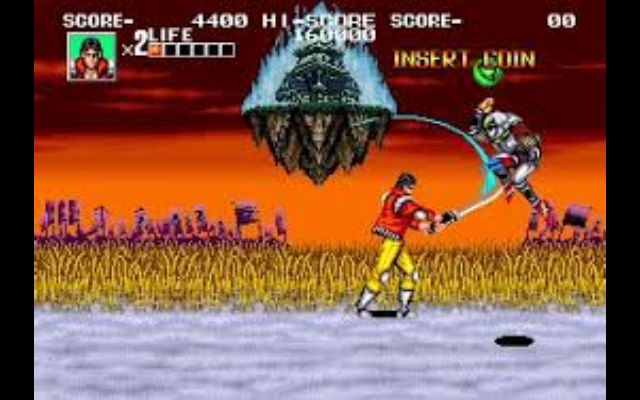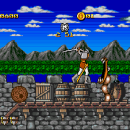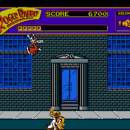Sengoku – The Arcade Classic That Combined Feudal Japan with Supernatural Action

Sengoku, released by SNK in 1991, is a unique beat ‘em up game that brings together the rich history of feudal Japan and the supernatural elements of Japanese folklore. Originally launched for arcades and later ported to home consoles like the Neo Geo, Sega Genesis, and SNES, Sengoku stood out for its distinctive setting, innovative gameplay mechanics, and the ability to transform into various warrior forms to battle evil spirits and undead samurai. With its combination of action, mythology, and intense combat, Sengoku has earned a reputation as a cult classic among fans of retro arcade games and beat ’em ups.
The Premise of Sengoku
Sengoku is set in a world where the past and present collide. Players take on the roles of two modern-day warriors who are transported back in time to feudal Japan, where a powerful warlord has risen from the dead to conquer both the past and the present. This warlord has unleashed an army of evil spirits, undead warriors, and supernatural creatures upon the world, and it’s up to the heroes to stop him.
The game’s storyline is driven by a blend of historical elements and supernatural themes. Players must fight through waves of enemies, traverse different dimensions, and face powerful bosses in order to defeat the warlord and restore peace. Each level is set in a different part of Japan, with backdrops ranging from eerie castles to mysterious forests, adding a sense of variety and scale to the adventure.
Innovative Gameplay and Transformations
Sengoku sets itself apart from other beat ‘em up games of its time with its innovative transformation mechanic. While the core gameplay involves the classic side-scrolling action of beating up enemies and moving from left to right, players can also transform into different warrior forms, each with unique abilities. These forms include a samurai with a powerful sword, a ninja who can throw shurikens, and even a dog with the ability to jump over enemies and obstacles.
These transformations add depth and strategy to the gameplay, allowing players to adapt to different enemies and situations. For example, the samurai form is excellent for close-quarters combat, while the ninja form is ideal for attacking from a distance. The dog form, on the other hand, is useful for evading attacks and reaching hard-to-access areas. Players can switch between these forms by collecting special orbs that appear throughout the game, adding an element of tactical decision-making to the otherwise straightforward combat.
The combat in Sengoku is fast-paced and challenging, with enemies coming from all directions. Players must use a combination of basic attacks, special moves, and transformation abilities to defeat waves of enemies and progress through the levels. The game’s enemy variety is impressive, featuring everything from zombie samurai and ninjas to giant ogres and spectral warriors. Each enemy type has its own attack patterns and weaknesses, encouraging players to experiment with different forms and strategies to overcome them.
Boss battles are another highlight of Sengoku, with each level culminating in a fight against a powerful adversary. These bosses are often larger-than-life characters with unique attacks and multiple phases, providing a satisfying challenge that tests the player’s mastery of the game’s mechanics. The combination of varied enemies, unique transformations, and challenging bosses keeps the gameplay fresh and engaging throughout.
Visuals and Sound Design
Sengoku is notable for its striking visuals and atmospheric sound design, which help bring its supernatural setting to life. The game features detailed pixel art that captures the dark and mysterious tone of its world, with richly designed backgrounds that range from haunted forests and eerie temples to war-torn battlefields and ancient castles. The use of color is particularly effective, with vibrant reds and purples contrasting against darker shades to create a sense of otherworldly menace.
Character sprites are well-animated, with smooth movements and expressive designs that give each warrior and enemy a distinct personality. The transformation sequences, in particular, are visually impressive, showcasing the different forms in all their glory and adding a dynamic element to the action. The game’s visual style is heavily inspired by Japanese folklore and samurai cinema, lending it a unique aesthetic that sets it apart from other beat ’em ups of its era.
The sound design in Sengoku also deserves praise. The game’s soundtrack is a mix of traditional Japanese instruments and modern synth beats, creating a blend that feels both ancient and contemporary. The music changes dynamically to match the pace of the action, heightening the tension during combat and boss battles. The sound effects, from the clash of swords to the roars of mythical creatures, add to the game’s immersive atmosphere and make each strike feel impactful.
Cultural Impact and Legacy
Sengoku may not have achieved the same level of fame as other arcade beat ‘em ups like Final Fight or Streets of Rage, but it carved out a niche for itself thanks to its unique setting, innovative mechanics, and challenging gameplay. The game’s blend of feudal Japanese themes with supernatural elements was relatively rare for the genre at the time, helping it stand out among its peers.
The success of Sengoku led to the development of two sequels, Sengoku 2 (1993) and Sengoku 3 (2001), which expanded on the original’s mechanics and introduced new characters, transformations, and gameplay elements. While the sequels retained the core concept of fighting through hordes of enemies in a mythological setting, they also added more depth and variety to the gameplay, refining the formula that made the first game a cult classic.
Over the years, Sengoku has gained a dedicated fanbase among retro gaming enthusiasts and collectors. Its unique blend of action, mythology, and innovation has earned it a lasting reputation as one of the more distinctive beat ’em ups of the early 90s. The game’s availability on various platforms, including digital re-releases on modern consoles, has ensured that new generations of players can experience its distinctive charm and challenge.
The Art of Mixing History and Mythology
What makes Sengoku so memorable is its ability to combine the gritty action of a beat ‘em up with the rich storytelling potential of Japanese folklore and history. The game’s transformation mechanic adds a layer of strategy and depth that keeps the gameplay fresh, while the diverse cast of enemies and challenging boss battles provide a steady stream of excitement. This unique mix of elements makes Sengoku more than just a typical beat ‘em up—it’s an experience that transports players to a world where history and myth collide.
The game’s art direction and sound design further enhance this experience, creating an atmosphere that draws players into its dark, mystical world. By blending traditional Japanese aesthetics with the fast-paced action of an arcade game, Sengoku manages to create a distinctive style that still feels fresh and engaging today.
Conclusion
Sengoku is a unique and engaging beat ‘em up that combines the best elements of arcade action with a rich, mythological setting. With its innovative transformation mechanics, challenging combat, and striking visuals, Sengoku offers a memorable experience that stands the test of time. Whether you’re revisiting it for nostalgia or discovering it for the first time, Sengoku remains a classic that showcases the creativity and innovation of early 90s arcade games. So, choose your warrior, embrace your inner samurai, and fight your way through the supernatural forces in Sengoku—a game where the past and present collide in epic fashion.









